Visualization Students Gain Real-World Experience In Virtual Production Through Summer Industry Course
Visualization students took a deep dive into virtual production during the annual Summer Industry Course.

Note: This story has been updated with the completed short films embedded.
Visualization students took a deep dive into virtual production during the annual Summer Industry Course.
Sixteen students created three short films on a virtual production stage at Stray Vista Studios in Dripping Springs, supported by the Virtual Production Institute, which is part of the Texas A&M College of Performance, Visualization and Fine Arts.
The student films will premiere on Friday at 11 a.m. at the Black Box Theater in the Liberal Arts and Arts and Humanities Building. Students will also show their films during a joint Viz Industry Partners and Performance Industry Partners Equivalent event on Nov. 22 in Fort Worth.
Virtual production stages incorporate large LED walls that display computer-generated imagery. These digital environments are created using real-time game engines. In-camera visual effects allow an integrated view of onstage actors and set pieces with the environment on the screen, thus eliminating the need for green screens. An early virtual production landmark was the 2019 Lucasfilm streaming series “The Mandalorian.” A minor in virtual production debuted this semester in the Visualization program.
Mayet Andreassen, co-instructor for the course, instructional assistant professor and associate program director for the Bachelor of Science degree in Visualization, said she is eager to share the students’ productions.
“I am really excited about promoting the films they created,” she said. “And getting the word out that Texas A&M has this amazing program. Look at what our students can do, because this is a big deal and it gets us on the map.”
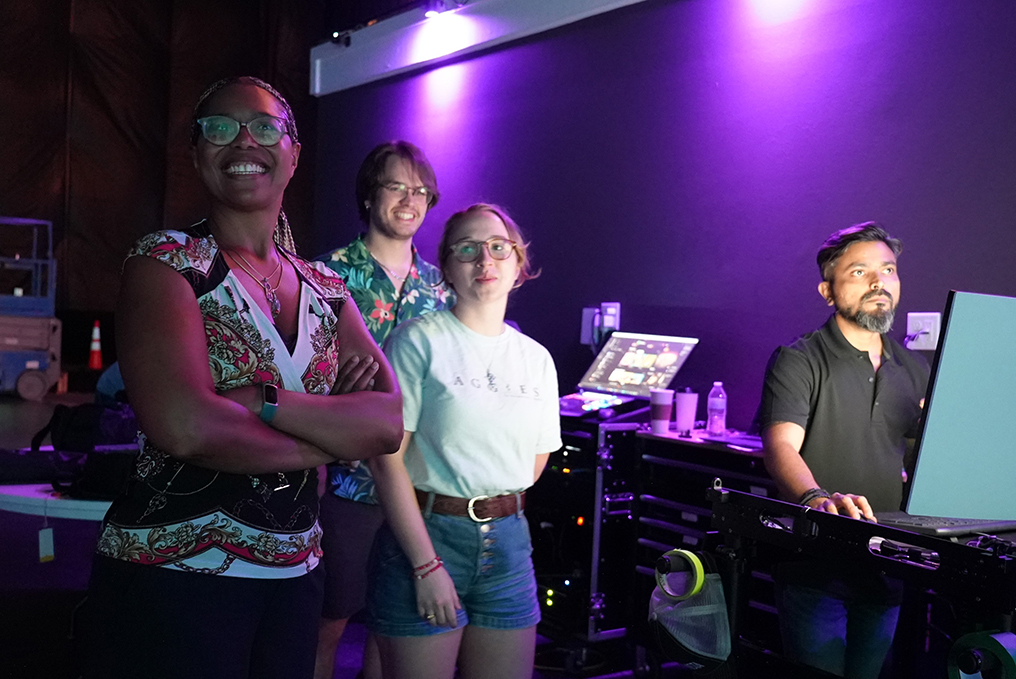
Taking The Stage
Seven undergraduate and nine graduate students split into three groups to produce the 2-minute films with 16 to 20 camera shots. The production process began with writing a storyline concept, developing a film script, and then building their production designs in Unreal Engine, a game engine owned by Epic Games.
Students had several Zoom classes with Stray Vista mentors, then went to Dripping Springs to film over two weeks. Students cast the actors and collected props, costumes and any other materials needed.
At Stray Vista, the environments students made in Unreal Engine were projected onto the large, curved LED wall, while students and mentors worked together in front of it.
“The students can essentially make any type of environment they want using Unreal, and it is projected onto the wall to make it look like the actor is on set in a different location,” said Caleb Kicklighter, instructional associate professor and co-instructor for the course. “Normally, filming a new scene would require the crew to find a place on Earth that matches that part of the story, and then film there. This can be very expensive and logistically challenging. But with virtual production technology, we can visually simulate those places onto a wall on set without having to leave the studio.”
In addition to the Stray Vista stage, the students worked with cutting-edge equipment including two cinema cameras and various lenses from Sony, which also made a $5,000 contribution toward student tuition for the course. A robotic camera arm was loaned by SISU Cinema Robotics.
Like a professional film production crew, students had specific roles within their group. Each crew had a director, assistant director, production designer, cinematographer and virtual operator.
Aaron Mouer, studio director for Stray Vista, said the students received real-world experience by solving problems that professionals face in the industry today.
“We will have some of the largest clients as far as commercial work that have stepped foot in here, and even those creative agencies and production companies are asking the same questions that the students are asking,” Mouer said. “Because this is such a new field and a new way of making movies and commercials.”
Mouer said this was the first time his team worked with students at this level, and they were impressed with the students’ work ethic and professionalism.
“This can be a very stressful job, and there is external pressure, especially when you are learning something new,” he said. “But the way they communicate with each other, they are still interacting with a total gentleness.”
Though many of the students weren’t familiar with the intricacies of virtual production prior to the course, all were eager to start filming, Andreassen said. She commended students on their willingness to learn something new.
“Especially when they got to the LED wall, their excitement level went up exponentially,” Andreassen said. “I’ve been really proud of the students. They have been professional throughout the entire course. They take feedback really well and take it to heart, and then they implement those changes.”
‘Abducted’
Tessa De La Fuente, a second-year Master of Fine Arts student, served as director for her group’s film “Abducted.” The story follows a man who lost his wife and is searching the woods to find her. The digital environment featured an eerie forest at night, with the main character resting amid camping gear.
The actor, Steve Brudniak, contemplates if aliens might have taken his wife. He confronts a beam of light and asks it to lead him to her. The light beam transports him to a “weird alternate dimension,” De La Fuente said.
“In the scene, he is disoriented, but he finds his wife’s ring and then he finds his wife,” she said. “You don’t actually see her face; you see her hands and it is this relief moment as he gets pulled into this haze of white where our film ends. It’s kind of left up into interpretation of ‘Did he find her? Is he with the aliens now?’ We don’t know, but he’s happy.”
De La Fuente said she focused on each small detail that could influence the final shot. The most rewarding part was crafting a storyline and experiencing a lead director role, she said. She hopes to pursue virtual production after graduation.
“I really worked on finding out where the best place was for me to be, while also figuring out how to be confident in myself and my vision,” she said. “When I first got to A&M, I was gunning for animation. I learned about gaming and VR. And now after this experience, I can see myself getting into virtual production in the future.”






‘Cardboard Camelot’
Hayden Hanna, a senior Visualization student, was the virtual production operator for his group’s film “Cardboard Camelot.” The story begins with a mother, played by actor Lucia Vico, discovering a castle her son made out of cardboard.
“She investigates the castle after noticing a strange light,” Hanna said. “She is then transported into a life-sized cardboard castle, seeing the world through his eyes. When you’re a kid, you build things, and they seem magical and gigantic. We wanted to capture that feeling using virtual production.”
The students received cardboard from Burr’s Unfinished Furniture in Downtown Bryan and donations from their classmates, which they used to construct the castle and various props. Hanna organized these props in the digital environment — a fantasy landscape featuring mountains, forests, rolling hills and a giant cardboard castle.
The most challenging aspect was effective communication, Hanna said, as everyone wanted to fulfill their roles properly. He added that Stray Vista mentors were encouraging and offered helpful advice.
“It was all worth it in the end, because it was so rewarding seeing all of our work on the screen — it’s crazy what a difference that makes,” Hanna said. “We are extremely lucky to have this experience. We get to try these jobs, learn from our mistakes and grow from them.”

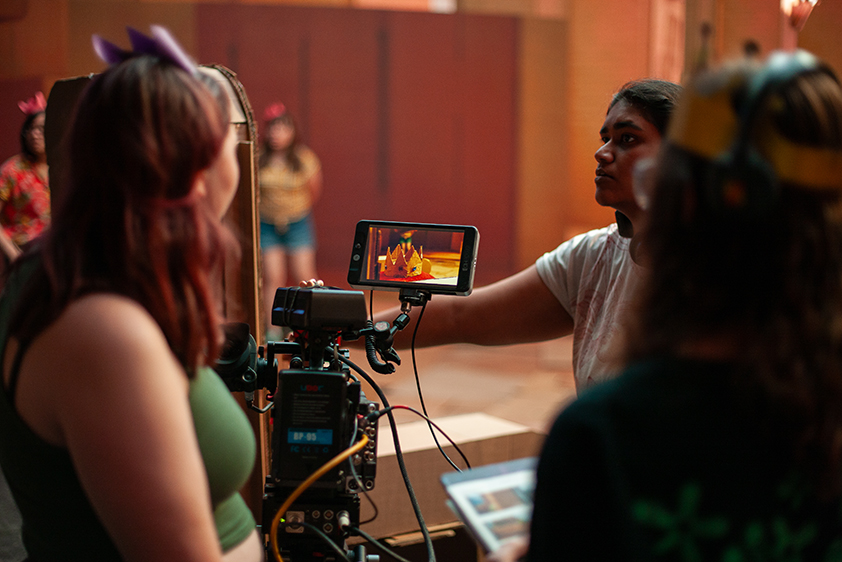
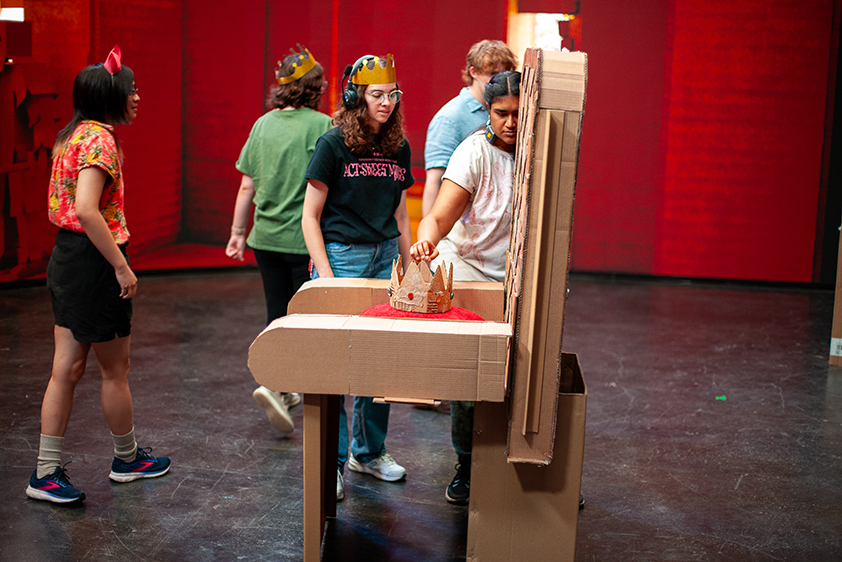

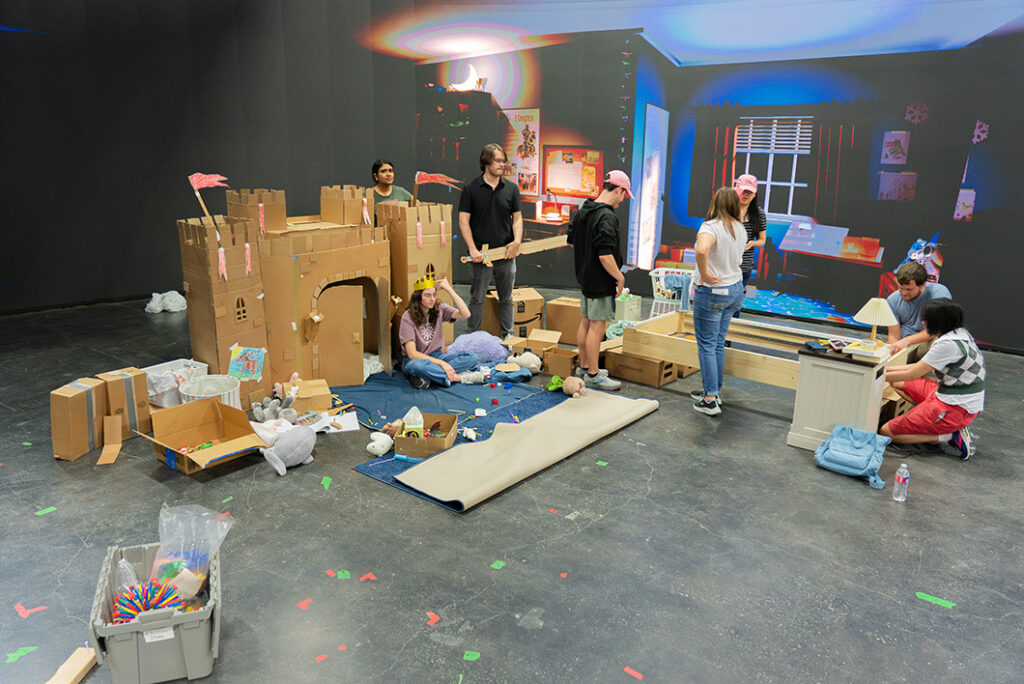
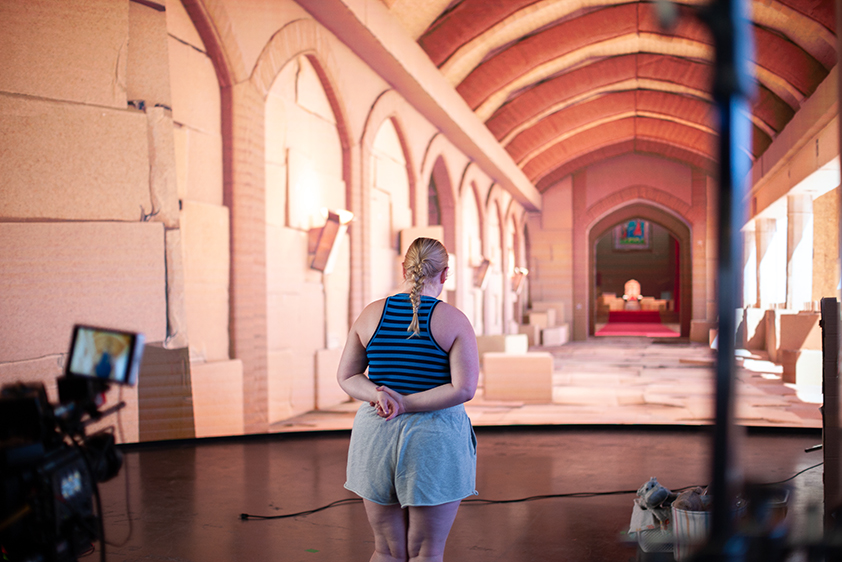
‘Winded’
Kasandra Thatcher, a second-year Master of Science student, was the cinematographer for her group’s film “Winded.” Their digital environment features a broken windmill that needs fixing in a futuristic paradise. The actor, played by Lilly Vandermark, gathers her toolbelt and climbs a ladder to reach the top of the windmill.
“She is really scared of heights, so she has to overcome that fear as she is climbing that ladder,” Thatcher said. “Once she overcomes that fear, she is very peaceful and has a really nice view on top of the windmill.”
Thatcher’s group supplied the set with ladder props, turf grass, plants and tools. Her role was to look for shots and plan what would look best in-camera while accounting for lighting and framing. Her group also used the robotic camera arm from SISU Cinema Robotics during filming.
“There is one shot where a piece of debris falls past the girl and she has to look down,” Thatcher said. “You see her reaction to that, and the robot camera does a really cool rotation to capture that shot, because it happens so fast.”
Thatcher said she most enjoyed using Unreal Engine and learning from the Stray Vista mentors. Although the 2-minute time constraint was a challenge, she said it helped her learn how to tell a story through visuals rather than dialogue. She also enjoyed making decisions in the moment.
“I loved being able to think on the spot, because you don’t really know how the environment will actually look until you are there,” she said. “You need to think about the set design on the spot, and how the framing is actually going to work.”
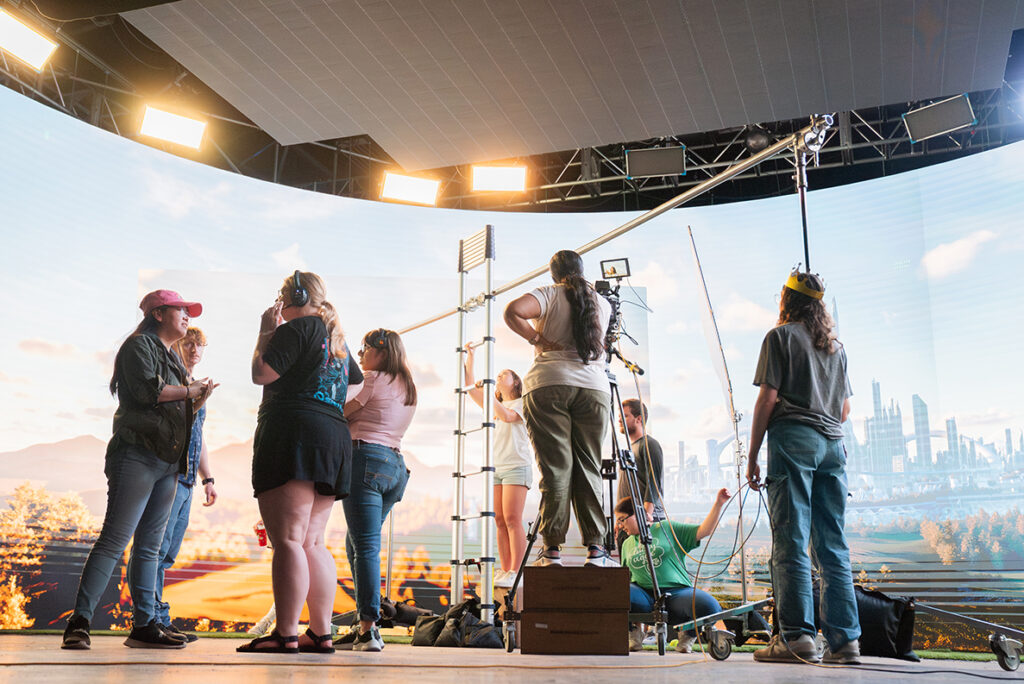


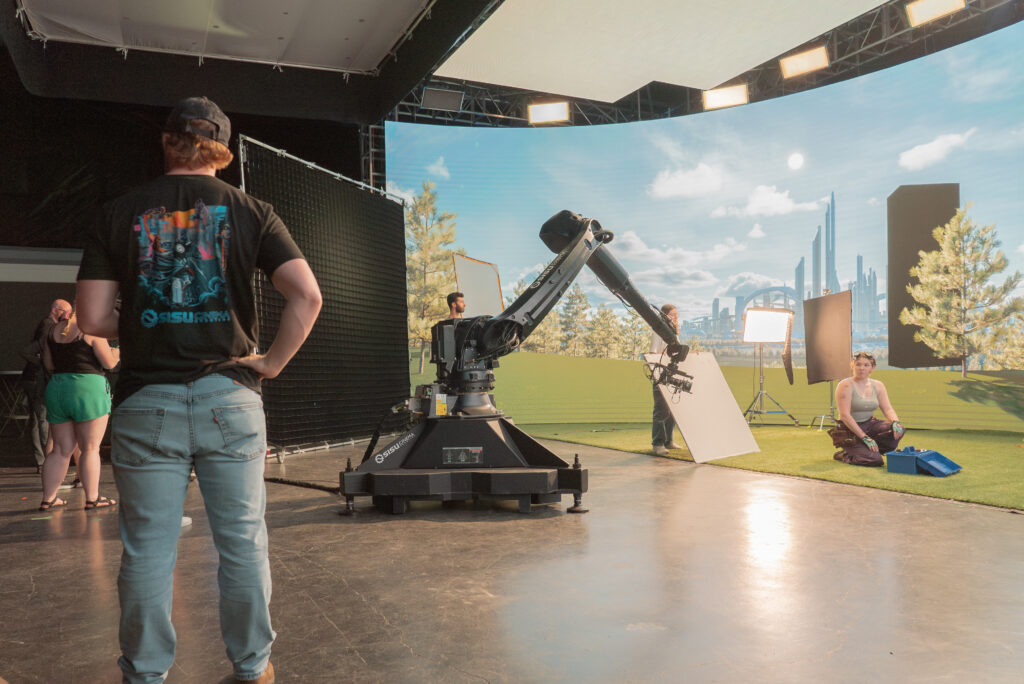
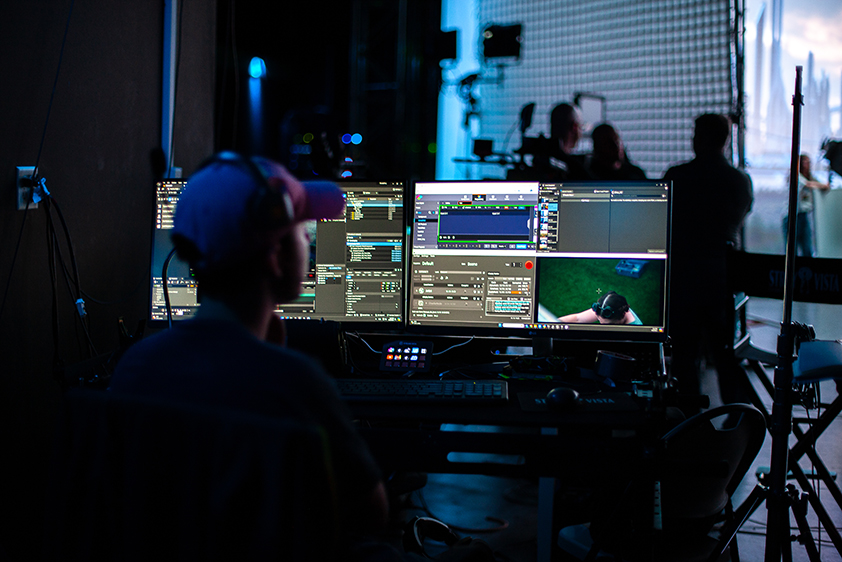

Future Impact
Andreassen said students in the course realized 3D computer graphics can be used for more than games, including animation and in producing feature-length and short-form films. This will give students more career opportunities in the industry, she said.
“Visual effects often seen in live-action movies are created using 3D assets and 3D worlds,” she said. “This experience is teaching students how to integrate that into several career paths. In the Visualization program, students learn about interactive design, multimedia design, animation, game design, virtual and augmented reality. But after experiencing virtual production, they had the opportunity to work for a visual effects company, and I think they realized they could create assets for these films, or even work in film.”
Wayne Miller, special adviser to the dean in the College of Performance, Visualization and Fine Arts, said the students quickly learned production storytelling techniques and how to storyboard narrative content. Miller, a producer/director who shared a lecture with the students on directing, said the course puts students at the same level of what virtual production professionals are experiencing now.
“As they graduate, they will already have the experience, knowledge and the know-how because they learned this in school,” Miller said. “Having their hands on the best equipment, and working with instructors and teachers working in the industry is very important.”
Kicklighter recalled that for each summer that he and Andreassen have taught the course, the students experience a bit of nerves at the start. They are still in a student mindset, he said, but have to perform at a higher level and take on a professional demeanor. Around the halfway point, Kicklighter notices that something has changed: Their confidence levels rise.
“They are able to make better informed decisions on their own,” he said. “A lot of them become teaching assistants or get snatched up by the company right when the class is over because our students are great people to work with. They are all very considerate, excellent communicators, and they know when to take the lead and when to work as a team.”
